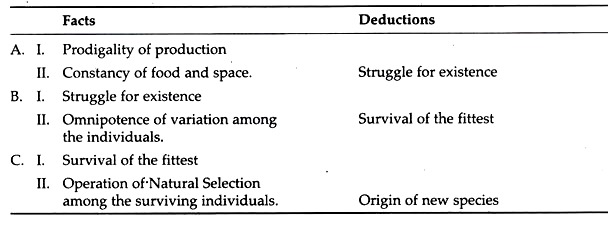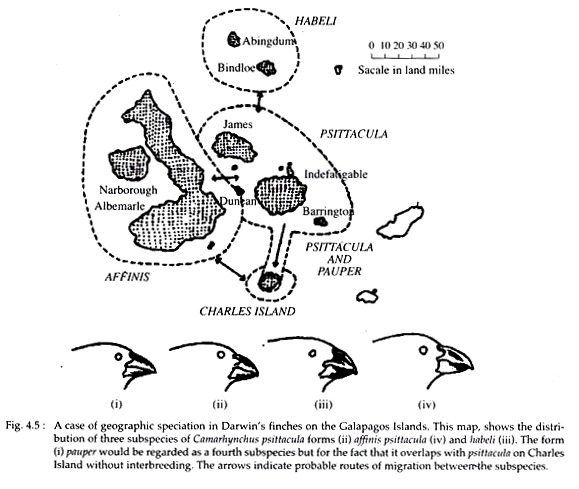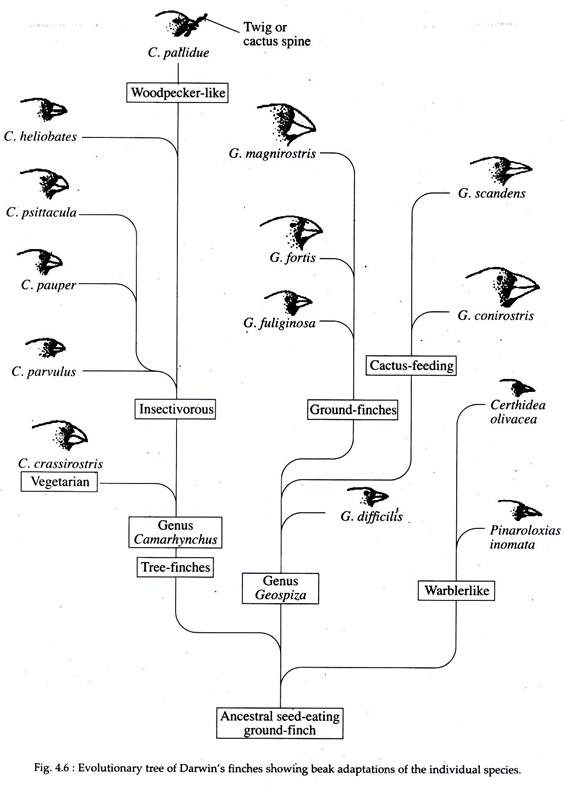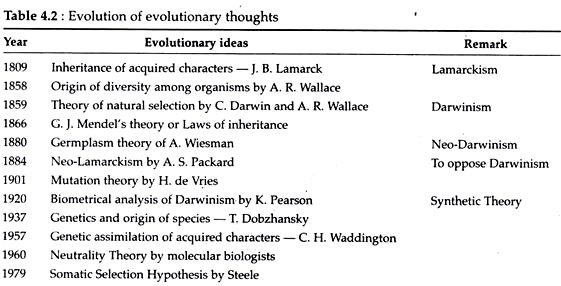In this article we will discuss about the Darwin Theory of Evolution:- 1. Introduction to Darwin theory of Evolution 2. Darwin-Wallace’s Theory 3. Observation of Darwin in Support of his Theory 4. Neo-Darwinism 5. The Synthetic Theory 6. The Neutrality Theory of Molecular Evolution.
Contents:
- Introduction to Darwin theory of Evolution
- Darwin-Wallace’s Theory
- Observation of Darwin in Support of his Theory
- Neo-Darwinism
- The Synthetic Theory
- The Neutrality Theory of Molecular Evolution
1. Introduction to Darwin theory of Evolution:
The majestic march of evolution started since life came into existence in this ever-changing panorama of the earth. The mystery of ‘mechanism of evolution’ attracts numerous evolutionists to unveil it. Among the huge number of ‘thoughts’, ‘concepts’ and ‘theories’, Darwin and Wallace’s theory of evolution was undoubtedly the foremost one. Their theory is popularly called as theory of ‘Natural selection’.
ADVERTISEMENTS:
Charles Darwin in 1859 published his book “On the Origin of Species by means of Natural selection”. In 1858, Alfred Russel Wallace, contributed a paper in a symposium of the Linnean society, entitled, “On the tendency of varieties to depart indefinitely from the original type”.
Both Darwin and Wallace went on expedition of nature, but separately. Both of them came to a theory, the working principle of which is exactly the same, i.e. Natural selection. Although they were working in different places, a warm friendship grew between them.
Darwin always recognised the originality of Wallace’s conclusion and their two research papers were combined and published under the joint authorship in 1859.
Darwin came from a rich family but Wallace’s social origin was very poor. So the whole credit of publication and findings went to Charles Darwin, and Wallace’s contribution was not credited. Therefore, we should consider both Darwin and Wallace as authors and the findings should read as Darwin and Wallace’s theory of Natural selection.
ADVERTISEMENTS:
ADVERTISEMENTS:
2. Darwin-Wallace‘s Theory:
The proposal of Darwin and Wallace regarding the steps of evolution can be summarised as given below:
Explanation of the Summary:
ADVERTISEMENTS:
Fact A. I. Prodigality of Production:
Power of multiplication or reproduction is one of the prime features of life. Organisms reproduce at a very high rate.
Example:
A female salmon produces 28,000,000 eggs in a season, Ascaris lumbricoides passes 7 lakhs eggs in 24-hours, an oyster liberates 114,000,000 eggs at a single spawning and Rana catesbiana produces 20,000 eggs annually.
Remark:
Darwin calculated and concluded that if all eggs spawned by an oyster survived and multiplied in a year, the shells would heap up to eight times the size of the earth. Darwin was acquainted with the famous doctrine of Malthus and found it is applicable to the animal world.
Fact A. II. Constancy of Food and Space:
Prodigality of production of organisms would result over-crowdedness in the area. But the food production and space of an individual’s habitat are constant.
Remark:
ADVERTISEMENTS:
Darwin believed that the prodigality of reproduction is very important because it results into crowded condition and sharp competition for the necessities of life. These competitions lead to the struggle for existence.
Deduction – A. Struggle for Existence:
Huge number of offspring’s in a habitat with constant food and space, face competition for survival. This phenomenon is called struggle for existence. This struggle is of three types.
(i) Intraspecific Struggle:
This is the competition between the organisms of their own kinds, i.e., same species.
(ii) Interspecific Struggle:
It is the completion between members of different species.
(iii) Environmental Struggle:
This is the struggle against the physical environments, such as, against excess of moistures or drought, against extreme temperature (cold or hot), against other geological conditions etc.
Example:
Suppose in a pond ecosystem, there are rohu, catla, koi, rana, prawn etc. If all are reproducing vigorously — what will be the result? The space and food for all these organisms in the pond is limited. In this condition if animals start breeding, a time will come when the pond will be full of all these animals.
It is known that all the above mentioned animals possess different food habits. So, at first, the offspring’s of rohu will compete with each other for food (intraspecific struggle).
Then the rohu will compete with catla and others for space (interspecific struggle). In addition to struggle for food and space they will also struggle for other purposes. After food and space they have to struggle against flood, temperature drought etc. (environmental struggle).
Fact B. II. Omnipotence of Variation Among the Individuals:
All living organisms of a species are not alike, they vary appreciably. For this reason children do not resemble exactly their parents. Nature itself also changes considerably from time to time. As the struggle for existence is universal and the variations become the rule of nature, some variants become advantageous in the struggle for survival while others are unfavorable.
Deduction – B. Survival of the Fittest:
Variation brings organic diversity in response to the environmental dynamics. The organisms with variation in structure, habits or instincts may be better adapted to new conditions and will have better chance of survival.
Consequently their offspring’s will inherit those variations. In course of time, these organisms will inevitably acquire superiority over the other less adapted forms. The survival of the superior forms is termed as ‘survival of the fittest’.
Fact C. II. Operation of Natural Selection among the Surviving Individuals:
Nature will select good varieties for survival. This selection operates amongst the fittest. Darwin proposed that the improvement of organisms tend to become more and more improved in relation to its condition. The improvement is examined and passed by ‘Natural selection’ test.
Deduction – C. Origin of New Species:
Any quality possessed by an individual, after ‘Natural selection’, which offers an advantage over others would be insured to the survivors. In subsequent generations, a large number of individuals with advantageous characteristics would be produced and disadvantageous characters would gradually disappear.
With repetition of this process in each generation all the survivors would be of the favoured types and would thus be selected.
A time would come, when number of favoured characters would be very high in a population. These accumulated characters would distinctly separate the new population from its basic former population. Ultimately these two populations would differ from one another, i.e., a new species will emerge from the old one.
3. Observation of Darwin in Support of his Theory:
In the Galapagos Island (Fig. 4.5), Darwin’s scientific curiosity was sharply prodded by the many distinctive forms of life. One of the many observations he made in this island, is a group of small black birds, now known as ‘Darwin’s finches’. He observed that the finches were different in certain respect on the various islands but they were obviously closely related to each other in some previous years.
The general appearances of the finches in different islands were similar, but their changes in beak shape occurred due to their food habit (Fig. 4.6). Darwin reasoned that the finches were derived from an ancestral stock that had emigrated from the mainland to the volcanic islands of Galapagos.
Probably, the ancestors of the finches faced trouble in mainland and migrated to the newly formed islands (Fig. 4.5). In the new area they had undergone profound changes under the different conditions of the individual islands. The new changes were selected by nature and ultimately gave rise to new species.
4. Neo-Darwinism:
The theory of Natural selection was proposed by Charles Darwin in 1859. It received a warm reception immediately. But gradually people began to loose confidence on Darwin. In 1866, in the Proceedings of the Natural Science Society of Brunn, Mendel published his paper which formulated the fundamental principles of the theory of heredity.
His theory accounts for biological inheritance through particulate factors (genes) inherited one from each parent, which do not mix or blend but segregate during the formation of the sex cells, or gametes. Mendel’s discoveries, however, remained unknown to Darwin as it was not known until 1900. If this would have been known to Darwin, he would have been able to explain his theory of “pangenesis” more reasonably.
In the mean-time, during 1870-1890, Darwinism faced an alternative evolutionary theory known as Neo-Lamarckism. This hypothesis shared with Lamarck’s, the importance of use and disuse in the development and obliteration of organs.
It also added notion that the environment acts directly on organic structures, which explained their adaptation to the way of life and environment of the organism. Proposers of Neo-Lamarckism discarded Natural selection as an explanation for adaptation to the environment.
In 1880 German biologist August Weismann, published his ‘germplasm’ theory. According to this theory two substances make up an organism. One, the soma, which comprises most body parts and organs and the other is the germplasm, which contains the cells that give rise to the gametes and hence to progeny.
Early in the development of an egg to the adult, the germplasm becomes segregated from the soma. From this notion, Weismann asserted that inheritance of acquired characteristics was impossible, and it opened the way for his championship of natural selection as the only major process that would account for biological evolution. Weismann’s ideas along with others became known after 1896 as neo-Darwinism.
5. The Synthetic Theory:
During the period of 1900 to 1950, mutationists (Mendelians), biometricians, naturalists, experimental geneticists, experimental biologists concentrated to formulate an universal theory of evolution. The outcome of their research is known as ‘the synthetic theory of evolution’.
Mendel’s theory of heredity (1866) was rediscovered by Hugo de Vries in 1900, who emphasized the role of heredity in evolution, de Vries proposed a new theory of evolution – the ‘mutationism’.
According to de Vries and William Bateson, there are two kinds of variation that take place in organisms. One is the “ordinary variability” observed among individuals of a species, which is not of any lasting consequences in evolution.
This could not lead to a transgression of the species border even under conditions of the most stringent and continued selection. The other is mutation – spontaneous alternations of genes that yield large modification of the organism and give rise to new species. Therefore, new species originates suddenly. It is produced from the existing one without any visible preparation and without transition.
The biometricians, led by Karl Pearson, during 1920s and 1930s greatly opposed ‘mutationism’ and proposed a resolution that Darwinian natural selection is the major cause of evolution, through the cumulative effects of small, continuous, individual variations.
Biometricians considered the theoretical work of geneticists, used mathematical arguments and came to the following deductions. First, continuous variations (in such characteristics as size, number of eggs laid, etc.) could be explained by Mendel’s laws. Second, natural selection acting cumulatively on small variations could yield, major evolutionary changes in form and function.
Distinguished members of this group was R. A. Fisher, J. B. S. Haldane, S. Wright, etc. But their work had a limited impact on contemporary biologists because it was formulated in a mathematical language that most could not understand. Moreover, it was exclusively theoretical. It omitted the mode of speciation, that was of great importance to evolutionists.
In 1937, Theodosius Dobzhansky published a book ‘Genetics and the Origin of species’, where he formulated a reasonably comprehensive account of the evolutionary process in genetic terms, laced with experimental evidences supporting the theoretical arguments. That is, he combined effectively Darwinian Natural Selection and Mendelian genetics. This is the landmark of the synthetic theory of evolution.
After the publication of ‘Genetics and the Origin of species’, interest in evolutionary studies was greatly stimulated. Several contributions from the varieties of biological fields started extending the synthesis of genetics and natural selection.
Among the prominent contributors, zoologists Ernst Mayr and Sir Julian Huxley, palaeontologist George G. Simpson and botanist George Ledyard Stebbins were present in addition to Dobzhansky. Their works gave rise to two new disciplines of biological sciences – population genetics and evolutionary ecology.
Stebbins discussed in detail, the synthetic theory and the various factors involved, in his book ‘Process of organic Evolution’.
According to him, there are five basic factors involved in the process of organic evolution. These are:
(i) Gene mutation,
(ii) Changes in chromosome structure and number,
(iii) Genetic recombination,
(iv) Natural selection and
(v) Reproductive isolation.
The first three factors are responsible for providing genetic variability and the last two for giving a direction to the evolutionary process. Details of factors i, ii and iii are described elsewhere. For further information, Stebbins’ book, ‘Process of Organic Evolution’; will be of great help for synthetic theory.
By 1950 acceptance of Darwin’s theory of evolution by natural selection was universal among biologists and the synthetic theory became widely adopted.
6. The Neutrality Theory of Molecular Evolution:
According to this theory, at the molecular level most evolutionary changes are selectively “neutral”, that is, they are due to genetic drift rather than due to natural selection. This concept emerged in the late 1960s, when molecular biologists entered the field of evolution.
They proposed that nucleotide and amino acid substitutions appeared in a population by mutation. If alternative alleles (i.e., alternative DNA sequences) have identical fitness and if they are identically able to perform their function, then changes in allelic frequency from generation to generation will occur only by genetic drift.
Evolutionists also postulated that a large proportion of all possible mutants at any gene locus are harmful to their carriers; these mutants are eliminated by natural selection. The neutrality theory also agrees that morphological, behavioural and ecological traits evolve under the control of natural selection.
Distinctive Claim:
(i) At each gene locus there are several favourable mutants (i.e., multiple allele), equivalent to one another with respect to adaptation, so that they are not subjected to natural selection among themselves. Which of these increases or decreases in frequency, in one or another species, is purely a matter of chance; the result of random genetic drift over time.
(ii) Neutral alleles are those that differ so little in fitness that their frequencies change by random drift rather than by natural selection. This definition is formally stated as
4Nes < 1
Where, Ne is the effective size of the population, and s is the selective coefficient that measures the difference in fitness between the alleles.
(iii) The rate of substitution of neutral alleles per unit time in the course of evolution (k) in a random-mating population with N diploid individuals, is
k = 2Nux
Where, u is the neutral mutation rate per gamete per unit time (the time units can be years or generations) and x is the probability of ultimate fixation of a neutral mutant.
The derivation of this equation is straightforward – there are 2Nu mutants per time unit, each with a probability x of becoming fixed. In a population of N diploid individuals there are 2N genes at each locus, all of them, if they are neutral, with an identical probability, x = ½N, of becoming fixed.
If this value of x is substituted in the equation above (k = 2Nux), the result is k = u. In terms of the theory, then, the rate of substitution of neutral alleles is precisely the rate at which the neutral alleles arise by mutation, independent of the number of individuals in the population or of any other factors.
Deduction:
From the above discussion it can be deduced that if the neutrality theory of molecular evolution is strictly correct, it will provide a theoretical foundation for the hypothesis of the molecular evolutionary clock, since the rate of neutral mutation would be expected to remain constant through evolutionary time and in different lineages.
The number of amino acid or nucleotide differences between species would, therefore, simply reflect the time elapsed since they shared the last common ancestor.
Discrepancies:
Tests of the molecular clock hypothesis indicate that the variations in the rates of molecular evolution are substantially larger than would be expected according to the neutrality theory. Other tests have revealed substantial discrepancies between the amount of genetic polymorphism found in populations of a given species and the amount predicted by the theory.
Defend:
The proposers of this theory argue that these discrepancies can be assimilated by modifying the theory somewhat; by assuming, for example, that alleles are not strictly neutral, but their differences in selective value are quite small. Be that as it may, the neutrality theory provides a “null hypothesis”, or point of departure, for measuring molecular evolution.



